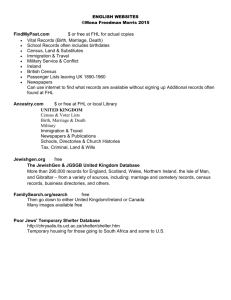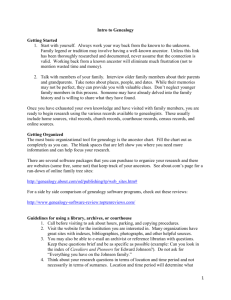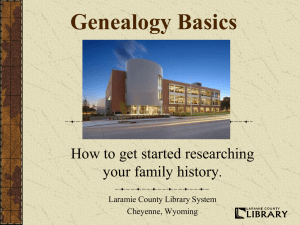Genealogy - Missouri Western State University
advertisement
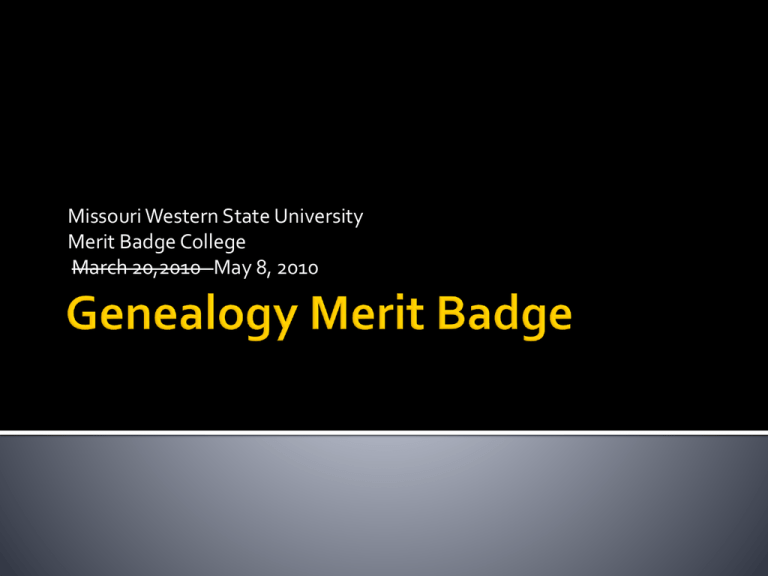
Missouri Western State University Merit Badge College March 20,2010 May 8, 2010 Please fill out the workbook as we discuss the different aspects of Genealogy. Genealogy (ge·ne·al·o·gy): the study or investigation of ancestry and family histories. Who were they? Where did they live? What were they like? Ancestor (an·ces·tor) a person from whom one is descended (parent, grandparent, great-grandparent, etc) Descendant (de·scen·dant) an individual descended from another (child, grandchild, greatgrandchild, etc) Create a timeline of your life. ▪ List Important Events: Birth, Schooling, Vacations, Scouting, Family, Memories. ▪ Ask parents and grandparents to tell you about things that occurred in your life before you can remember Use these notes to write a short biography of yourself. Update this timeline and biography every year. Write in a Journal Talk to your parents and grandparents. Ask them about their childhoods. ▪ Where did they go to school? ▪ What were their friends like? ▪ What did they like doing? What were their brothers/sisters/cousins like? What do they remember about their parents/grandparents/aunts/uncles. Record their stories (Tape and Written) Letter from my Great Grandfather Charlotte Holmes: The biggest, hardest thing in our family was when my older brother Chuck got sick; he was about twelve (in about 1924). This was a bone infection and there was not antibiotics or sulfurs or nothing of that sort at the time. Four years later they took off his right leg above the knee. He spent a good deal of time in the hospital and in bed at home. While he was a boy scout he had a Model-T Ford because his uncle Walter made sure that he had one so that he could get around; he couldn’t walk very far by himself on his artificial leg. Well, there was a voting contest to send one boy to scout camp for free and another boy in town got it. But then they discovered that there were a lot of votes that hadn’t been counted and most of them went for Chuck. The other boy had already left when they told him about it so Chuck rushed home and told my mother that he was going to camp. He got his gear together, jumped in his Model T and rode off down around Lake Michigan and he managed to get there. Well, my father came home and he was pretty upset. My mother told him “I couldn’t have stopped him if I wanted to.” Chuck had a wonderful time at camp. He worked with the scouts in Batavia in the 1950’s and 60’s until he retired on the farm. Vital Records Birth, Marriage, Death records Census Records Every 10 years from 1790. Privacy laws mean that only through 1930 have been released State Records Land deeds, wills, pension records Libraries Books and microfilm resources Internet Family papers, bibles etc. Birth Obituary Will Census Primary Records: A record that was created at the time of the event. Birth Certificate, Death Certificate, Marriage Record, etc. Only primary source for that event. Secondary Records: Information recorded at a time other than the event. Example: Birth date listed on death certificate. Secondary information can be incorrect. If a close family member were to die, and you were asked to fill out the death certificate, would you be able to accurately remember that person’s birth date, mother’s maiden name, etc. Primary Source: Data that was recorded at the time of the event. Birth date Birth Place Parent’s Names Secondary Records: Information recorded at a time other than the event. Mother’s or Father’s Birth date and place Primary Source: • Death date • Death place • Burial Place Secondary Source: • Birth Information • Parent’s Information • Spouse Information Primary Source: Marriage date Names of Spouses Marriage Place Secondary Source: Parent’s information Birth dates and places Taken every 10 years as required by the US Constitution 1790 – 1840: Lists heads of households only 1850 – 1930: Lists all members of household 1940 – 2010: Not released to public yet. 1890: Destroyed by Fire Information obtained from Censuses: Names of Family Members Ages at time of Census Birth Locations Where the Family Lived Not Terribly accurate! - neighbors frequently gave information. Only as accurate as the census taker. Information gathered and published by other researchers May Contain Errors Motherwell Memories Family: Check with your parents/ grandparents, etc to see what records they have. Make photocopies or scanned images of these records. Record Repository: courthouse, state or national archive, state library, genealogical library. Internet: Watch for Primary, Secondary, and “Dubious” records. Storage of Information: FamilyTreeMaker Legacy Ancestral Quest Sharing of Information: Internet Sites E-mail Digital Photos Finding Information: Online Records Computerized Document Searches Googling Microfilming: Copying old records onto film that can be viewed and copied. Allows more access to records that are falling apart. Allows microfilms to be copied and stored in multiple facilities (libraries). Duplicate copies in case originals are destroyed. Microfilmed copies are now being digitized and copied into computer databases. Start with yourself as #1. Next is your Father (up) and Mother (down) Each generation continues in the same way: Grandfather (up) and Grandmother (down) List Father on Top Line Mother on Next Lines Children in Order of Birth Use Extra Pages if Necessary List only one family per sheet Do your detective work! That’s great evidence – make sure you record where it came from. • Do you have an original record? • Did you get it from someone else’s research? That’s questionable – check out their sources – hang on to the information as a “possible” • State something as a fact only when it is supported by convincing evidence, and identify the evidence when communicating the fact to others. • Keep your mind open – your ancestors may not be who you think they are Use this time to complete Timeline / Personal History Prepare questions for relatives Fill in Pedigree Chart and Family Group Records Search Internet for Resources I will come around and check off requirements for those who have completed the prerequisites.
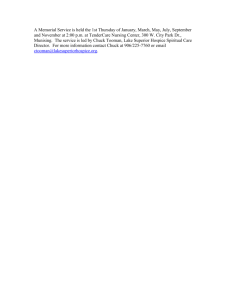

![Application for a Marriage Certificate [Word]](http://s3.studylib.net/store/data/006667772_1-b8d08b992ee6940ed10456ff6ea784ed-300x300.png)
